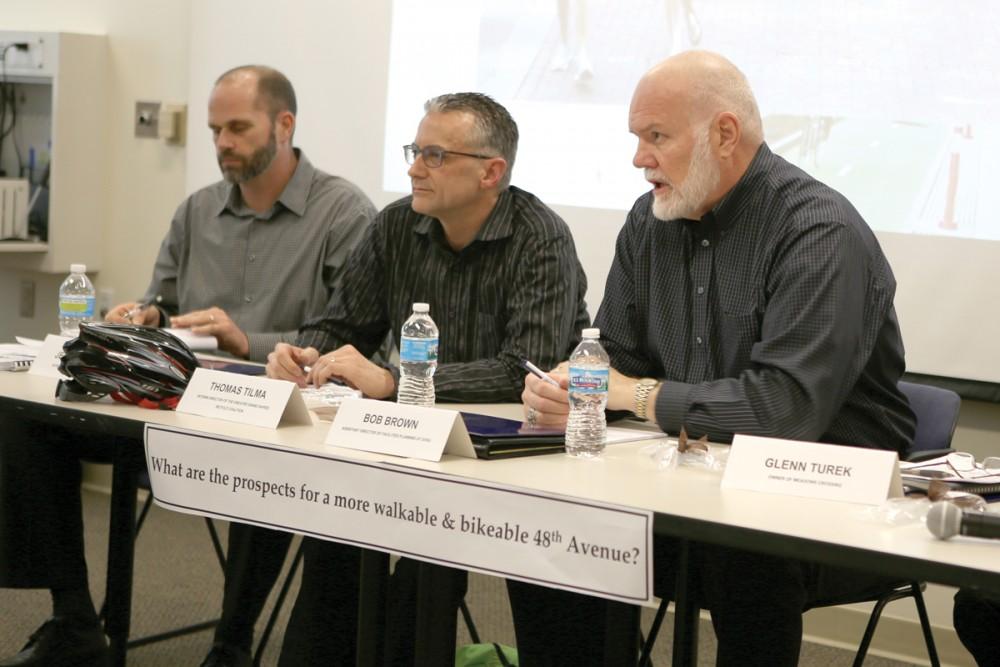Transportation Planning students organize panel of experts for discussion on the future of 48th Avenue

GVL / Anya Zentmeyer Bob Brown (on the right) speaking during a panel held to further discuss the expansion of making 48th Ave. in Allendale a more walkable and bikeable option.
Apr 18, 2013
In every course Patricia Houser teaches in her department at Grand Valley State University—Geography and Planning—she has the same theme.
“The theme in any urban planning course is that what we do with the landscape comes back and affects us,” Houser said. “You can’t pick something more profound than what you do with a corridor in the landscape and how that can affect the land uses around it and the well being of the people around it.”
So when she and her Introduction to Transportation Planning students decided to replace their final with a project that has tangible consequence within the GVSU community, they embarked on “Project 48,” which culminates with a panel discussion that includes experts within the Allendale community and local planning agencies who offer perspective on the ongoing concern in the area surrounding the future of 48th Avenue.
While Ottawa County has plans underway to widen 48th Avenue south of M-45, with intent to at least double the lanes, Houser said after researching the subject, she and her students came to two conclusions.
“The first issue is that a big change is coming, and nobody knows about (it),” Houser said. “That’s just the nature of planning anyway, everywhere. In that sense it’s nobody’s fault… I think we have to figure out a way when you deal with a transient community—a community that’s in for four years and that are doing their homework and it’s not the easiest thing for them to get to a meeting downtown—a way to engage them. Because they are important.”
The second was more complicated, involving what they see as potentially flawed logistics behind the origins of the plan to widen 48th Avenue, which are based on a 2001 Grand Valley Metropolitan Council study that uses a formula to project future traffic congestion in proportion to projected population growth.
“You’re proposing a fast moving road in a densely populated place where people are crossing the street. That’s normally not a good thing,” Houser said. “So my class has said, ‘Let’s look at what else would go here and what would be better here.’ And it’s such a great case study because the quintessential question in planning is what do we do with the landscape and how does it come back to affect us. So within that, the narrow question that’s most effective in any given planning study is, what do you put where; and in this, we’re saying, ‘Not here. We don’t think this goes here.’”
After a series of influential speakers, including Jerry Alkema, Allendale Township Supervisor, and a GVSU alumnus who graduated to become part of the team who initially proposed the 48th Avenue plans, Glen Turek, property manager of the off-campus housing complex Meadows Crossing, Houser’s students became engaged with the subject and started to conceptualize how important stakeholders were in an urban planning project like the plan to widen 48th Avenue.
“I’m going to say, this is an opinion this is not a technician coming in, and the first thing [Turek] said was, ‘My brother was hit by a car when he was six.’ You could sense the change in the room, and I certainly saw it by the end of the period, they realized this isn’t just books anymore,” she said. “This matters. And that’s when the tone changed.”
This is the first time Houser has ever replaced a final exam with something like Project 48, and she said although the combination of course objectives and collaborative project management work that mirrors the real world has called for a lot of flexibility within he course, the energy the students are bringing is affirming.
The night the class began to conceptualize the project, Houser put up an assignment on Blackboard that outlined an action plan. Though the first drafts were proposals, the students will flesh them out and turn them around in portfolio form as their final exam product.
“When I realized how flexible this was going to have to be, at the very least, you need to be conscious of why you’re doing,” Houser said. “So I kind of shared with them the objectives and I had them constantly tell me ‘what’s your objective here?’ so that they’re making sure they are fulfilling the objects for the public, as well as for the course. So, it’s a strange hybrid of working toward a public goal and meeting teaching standards and content standards.”
The class chemistry, she said, was another advantage.
“This was a group that was just game to try things, and just interesting in everything they learned,” she said. “It was just an engaged group, I think.”
Students including Lindsay Harris, who isn’t an urban planning major, said this class—more specifically, this project—has sparked her interest in the subject. She said the night they came up with Project 48, there was a palpable sense of purpose among her classmates.
“We were like, ‘You guys, we could actually do something about this,’” she said. “This is a big issue, and nobody knows about it. None of the students know about it. If we’re not going to say something or educate people then who will?”
The panel discussion will be hosted April 16 at 7 p.m. in room 2215 of the Kirkhof Center.
For more information, visit the website created for Project 48 at www.gvsu.edu/Walk48.
[email protected]

























